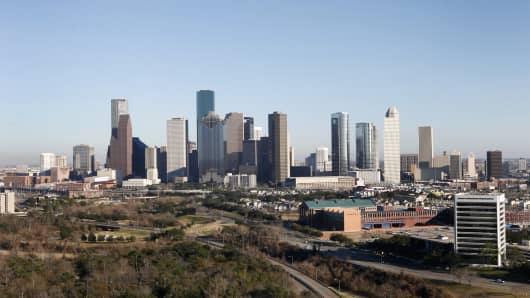Metropolitan areas in Texas saw the fastest economic growth as the recovery took hold in 2011, but the New York City region still had the largest gross domestic product in the United States, according to federal data released Friday.
Altogether, GDP increased in only two-thirds of the U.S. metropolitan areas, which are defined as at least one major city and its surrounding suburbs.
Odessa, Texas, experienced the fastest growth in the country from 2010, 15.2 percent, largely due to expansion in wholesale and retail trade, the Commerce Department said.
Of the 10 largest areas, the fastest growth was in the Texas oil hub of Houston, at 3.7 percent, followed by another major Lone Star State city, Dallas, at 3.1 percent.
In the New York area, which includes parts of Long Island and northern New Jersey, GDP was $1.28 trillion in 2011, compared with $1.25 trillion in 2010. The second largest economy, Los Angeles, which also includes the major port town of Long Beach and Santa Ana, was nearly half the size of New York's, at $747.31 billion.
Cities and counties were hit hard by the 2007-09 recession, scrambling to provide for residents who had recently lost their jobs or homes just as their major source of revenues — property taxes — collapsed from the housing downturn.
In 2009, Congress and President Barack Obama stepped in with an economic stimulus plan that provided the largest transfer of federal funds to states in U.S. history. Many of the funds trickled down to cities, which were also able to take advantage of borrowing programs and grants created in the American Recovery and Reinvestment Act.
Metropolitan GDP growth in total slowed to 1.6 percent in 2011 from 3.1 percent in 2010 as the last of the stimulus money made its way out of the economy. For the 10 largest areas, which account for 38.1 percent of the country's metropolitan GDP, growth slowed to 2 percent in 2011, compared with 3.1 percent in 2010.
Professional and business services contributed strongly to metropolitan growth in 2011, as did manufacturing.
Still, GDP in many places shrank in 2011. The largest decline was in Sioux City, Iowa, where GDP fell 5.2 percent.
While the California Bay Area cities of San Francisco, Oakland and Fremont experienced growth of 2.6 percent, most of its neighbors in the central valley saw declines of at least 0.5 percent.
Cities in Florida had patchy performance as well. In many areas along the state's east coast, GDP shrank or barely grew, but those along the west coast experienced expansion of at least 1.3 percent.


